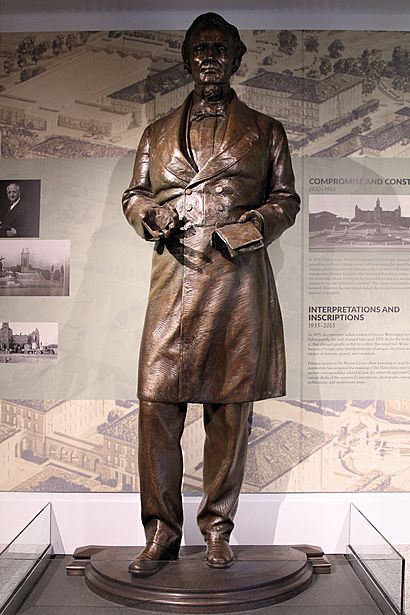Statue of Jefferson Davis (Austin, Texas) facts for kids
Quick facts for kids Statue of Jefferson Davis |
|
|---|---|

The statue in the Dolph Briscoe Center for American History, 2018
|
|
| Artist | Pompeo Coppini |
| Year | 1933 |
| Medium | Bronze |
| Subject | Jefferson Davis |
| Dimensions | 260 cm (102 in) |
| Location | Dolph Briscoe Center for American History, Austin, Texas, United States |
| Owner | University of Texas at Austin |
The Statue of Jefferson Davis is a sculpture created by Pompeo Coppini. It shows Jefferson Davis, who was an important political leader in the Confederacy during the American Civil War. This statue was ordered in 1919 by George W. Littlefield. He wanted it to be part of the Littlefield Fountain at the University of Texas at Austin. The statue was placed on the university's South Mall in 1933. It stayed there until 2015. Then, it was moved to the Dolph Briscoe Center for American History in Austin, Texas.
Contents
How the Statue Was Made and Moved
In 1919, a man named George W. Littlefield gave money to the University of Texas. He was a regent, which means he helped manage the university. Littlefield wanted to build a "Memorial Gateway" at the university's south entrance. This gateway was meant to honor people who fought for the Confederacy during the American Civil War.
Who Designed the Statue?
Littlefield hired Pompeo Coppini, a sculptor from San Antonio. Coppini was born in Italy. He was asked to design the monument. The plan was to include statues of famous people from Texas and the American South.
The Littlefield Fountain Project
The memorial project changed over time. It became the Littlefield Fountain. This fountain was dedicated to students and alumni of the university. These were people who had died in the Great War, which is now called World War I.
Where Were the Statues Placed?
In the 1920s, Coppini created six bronze statues. One of them was the statue of Jefferson Davis. The other five were of important figures chosen by Littlefield. Coppini first planned to put these statues around the fountain. However, as the fountain was being built in the early 1930s, the university's architect, Paul Cret, made a different choice. He decided to place the six statues along the university's South Mall. They were installed there in 1933, when the fountain complex was finished.

